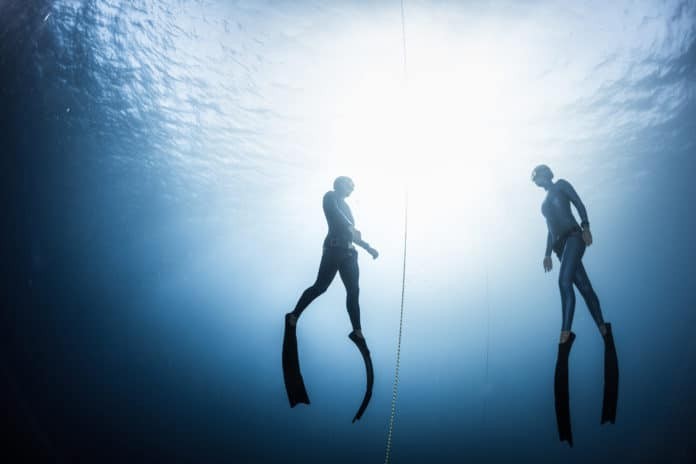There are a few common mistakes that most beginner freedivers make. During a freediving course, the aim of each session is to build confidence, develop safety knowledge, and fine-tune technique, so these common mistakes usually get fixed over the duration of the course. But sometimes, after a long period of not getting in the water and training, freedivers may forget certain techniques they worked so hard to perfect. There are also freedivers who learned through YouTube videos or by themselves (which is not recommended) and did not have an experienced coach or buddy to correct the little things. For reference, we will refer to a beginner freediver as someone who reaches maximum 20m (65ft), which is usually the maximum depth for the first certification course of most organizations. Here are the 5 most common mistakes made by beginner freedivers and how to fix them.
1. Bicycle-kicking
As popular in freediving as it is in scuba diving, bicycle-kicking is a common mistake in the diving community. Instead of kicking from the hips in wide arcs, some beginners kick from their knees while also moving their legs at the hips. This results in a seriously inefficient fin stroke and is wasted movement that will only use up more of your precious oxygen. Practice laps in the pool over and over again, and have a buddy videotape you if necessary until you have verified that you are kicking directly from your hips with straight legs, thereby utilizing maximum efficiency.
2. Looking up during a dive
Not everyone feels confident with depth at the beginning of their freediving careers, and it may take a while to break the habit of looking up while diving to see how far away the end of the line (or the surface) is. This habit will make equalization more difficult, while also causing you to inadvertently move further away from the line due to an arched back. As you continue to deeper depths, this position can also open you up to throat injuries. This error is usually fixed by repeatedly being reminded to tuck the chin in, and also becomes easier as a freediver gains confidence and conservatively progresses through depth.
3. Tensing the neck and/or chest
While the Frenzel technique is still fresh in a freediver’s mind, they may consciously think about it at depth. Instead of using muscle memory to automatically equalize, a beginner might consistently doubt themselves and debate on where to place their tongue or wonder if they are accidentally performing Valsalva. With this lack of confidence comes nervousness, which can cause tension in the neck or upper chest, thereby impeding equalization. Solve this issue by practicing Frenzel on land over and over again (seriously, just watch a movie and Frenzel away), until it becomes automatic. Once Frenzel becomes a reflex, more effort can be put into relaxation, which helps facilitate equalization.
4. Line orientation
Beginners sometimes have trouble with line orientation, whether it is not duck diving in front of the line, constantly running into or further away from the line, or staying too far from the line throughout the entire dive. Measuring the number of kicks you need at the surface to place yourself in front of the buoy can be useful until you naturally have a feel for perfect placement for a duck dive. If you are constantly running into or away from the dive line, check if you are tucking your chin too much, causing you to run into the line, or extending your chin upwards, which will cause you to fin away from the line. If your head position is not the problem, have someone watch your fin strokes, and see if you have too strong of a backward stroke, which pushes your body forwards. As for general line positioning, you should be roughly an arm’s distance away from the line, so that you can stop descending immediately if needed.
5. Not using the buoy for support during recovery breathing
If you dive too far from the line, it is likely that you do not correct the distance by the time you reach the surface, which means surfacing a good distance away from the buoy. The buoy is there for support; you should be surfacing directly in front of it so that your first movement is to throw your elbow over it and hold yourself up while you are recovery breathing. There is nothing worse than surfacing from a long dive, only to have your recovery inhale become interrupted by a wave that drives salt water directly into your lungs. Make sure to avoid straying too far from the dive line, and to always look up the last few meters of a dive so that you can adjust your position accordingly.

